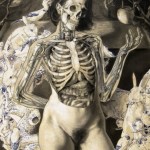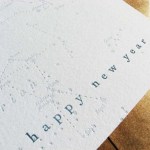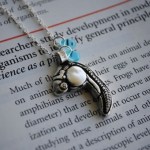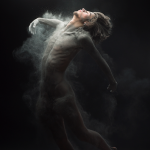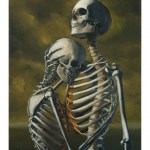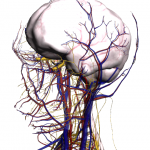
Michael Reedy's drawings are like 1980s Visual Man and Woman models plopped down in a half-excavated quarry of visual and literary allusions. He achieves a cut-paper, graphic feel by composing on superimposed planes, sort of like a stage set, with strategic uses of outlining and negative space. And he is a master of figure drawing (he teaches it, so he'd better be). When an artist really knows figural anatomy, he/she doesn't need to do anything flashy with it: you can just tell.
While it's not one of the overtly anatomical drawings (like malum E, above), I'm totally captivated by Blash, a…
Hans Rosling's Joy of Stats is now available in its entirety (one hour) from YouTube! Thanks to flowingdata for the heads up.
. . . especially with these delicate, icy Orion constellation cards from Campbell Raw Press.
This series of sciart wallpapers by Dan Funderburgh were inspired by the Time-Life Science Library, a series of educational books published in the 1960s. For those of us old enough to remember them, Time-Life's series are objects of nostalgia in themselves. Coupling the vintage design and palettes of those books with vintage sci-art symbolism yields a sharply contemporary set of prints.
Funderburgh describes his work as "a repudiation of the fabricated schism between art and decoration;" you could also describe it as a repudiation of the fabricated gulf between science and design. (Fun…
Fabrication de bonbons à Berlin from philmotion productions on Vimeo.
Via NOTCOT.
No. "If we could gather all the electric eels from all around the world," they would free their imprisoned brother from his Yuletide servitude and bio-tase the crap out of you, bro.
Just sayin'.
I have no idea how I missed this before the holidays (sorry!), but NBDesigns has a line of oxidized silver embryo jewelry that is pure vintage lab-chic. The embryonic mice are particularly adorable:
And, on the less-cute, more-sciency end of the spectrum, her embryonic chicks look just like illustrations in an old dev bio textbook:
I should also note, since we are coming up on Valentine's Day, that she makes Erlenmeyer flask earrings and pendants with little hearts. (You can also request a glass heart worked into the chain of the zebrafish embryo pendant, or check out her sloth & heart…
Tatiana Plakhova's "Music is Maths": what cathedrals should look like on the TRON Grid.
Via fubiz.
Via iO9, a Nature News slideshow of natural history engravings by physician Martin Lister's teenage daughters, who contributed technically accurate engravings of shells to one of his books, the Historiae Conchyliorum:
Historians now believe the pair were the first women to use microscopes to help produce some of their scientific drawings. Anna and Susanna's place in the history of science is explored in a biography of Martin Lister in preparation by historian Anna Marie Roos of the University of Oxford's Cultures of Knowledge project. In a recent web post, Roos describes how she stumbled…
Because people have been discussing Google ngrams a lot, and because there are always major caveats to new datamining methodologies, I have to link Natalie Binder's excellent series of posts urging caution, not only about the methodology, but about assuming too much about ngrams' utility in social research.
Binder says,
The value of the Ngrams Viewer rests on a bold conceit: that the number of times a word is used at certain periods of time has some kind of relationship to the culture of the time. For example, the fact that the word "slavery" peaks around 1860 suggests that people in 1860…
The ultimate bioephemera: art you eat! This cephalopod by specialty cake artist Karen Portoleo is definitely NOT a cake wreck (although if there were a little cake(ship)wreck under those tentacles, it might not be a bad addition). Karen previously made a "gingerbread" house with an octopus icing and tiling the roof. For serious.
Thanks to Patricia for the link! (Check out Patricia's art blog, too).
Olivier Valsecchi's portraits of the nude human body, caught in motion, haloed in dust, could convey an incredibly complicated subtext. Or not. "Dust" by Olivier Valsecchi, via ChangetheThought via Street Anatomy.
Raise your fingers if this video by Cyriak kinda creeps you out.
Via Street Anatomy.
National Museum of Health & Medicine has an amazing flickrstream of vintage medical photographs and other ephemera. Lately they've been adding diagnostic/documentary photos of Civil War soldiers, as well as some military propaganda posters (anti-VD and anti-food waste, of all things). This series of photos of a lab setup for measuring cranial capacity are my favorites. Check out the handled basket of skulls! And they're using an "insufflator!" I did not even know that was a word.
Happy holidays to our friends at Bottled Monsters and thanks for all the wonderful photos!
Water + physics = beautiful work by Shinichi Maruyama.
Via Neatorama - thanks to Rhett for the tip.
To Hold You Again
Chris Peters
Artist Chris Peters just wrapped up a winter show at Santa Monica's Copro gallery. I've blogged about his work before; it's inspired by vintage medical illustrations, but his agonized skeletons are ripped from their anatomical atlases to brood in Hopper-esque gas stations, Mad Men-like interiors, and smoky chiaroscuro. Whether you find his work creepy, Goth-chic, spiritual, or even humorous, it's a skilled and thoughtful reboot of the classic tropes of medical illustration.
I'm sorry I didn't get this posted before his latest show closed, but Copro has a…
As children sleep, dreaming their materialistic dreams of the privileged classes, Santa - less impressive than his Falstaffian reputation would suggest - twists the narrator's grasp of reality beyond all recognition.
A hilarious tale of Christmas horror by Ryan Iverson, inspired by Warner Herzog. Via iO9.
Google Labs just released a new "experiment" - Body Browser. You have to upgrade to Google Chrome beta if you don't already have it, but when you do, you can play with a 3-D, rotatable reconstruction of a (female) human body. Sliders let you fade the circulatory, skeletal, muscular, and nervous systems in and out over the body organs; you can toggle labels on and off, and you can zoom, spin, and rotate in a way that would only be cooler if it were on a touchscreen iPad. (Yeah, that's what I said, Google. Do it!) Check out this screenshot:
Toggle a few sliders and you can wrap the vessels and…
Euw! Ed Yong has a gross-yet-cool post about parasitic nematodes that infect and kill caterpillars - and bring along luminous bacteria whose red glow is unpalatable to birds. If a bird eats the caterpillar host, the parasitic worms die. But the bacterial warning glow protects the worms' immobilized corpse home until they mature and burst out of the dead caterpillar - as grossly as possible, of course. (See photo on Ed's blog).
Natural, uber-gross bioephemera! Thanks, Ed. :)
This is un freaking real.
My friend John O at Armed With Science has dug up a classic animated film produced for the National Naval Medical Center in 1973. It starts with an awards ceremony for the "Communicable Disease of the Year," hosted by the Grim Reaper (who turns out to know a lot about medical history.)
The top prize is won by the Dracula-esque Count Spirochete (AKA syphilis), over the vociferous objections of a shortlist of other diseases, including smallpox ("I've scarred and disfigured millions of people!") and gonorrhea (who resembles a lavender Tribble with a pitchfork). The…
